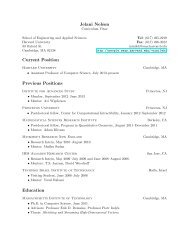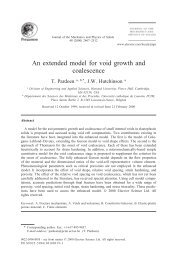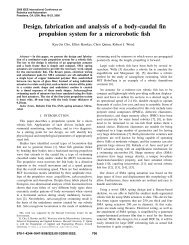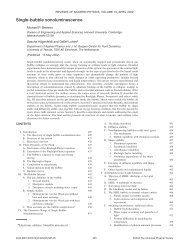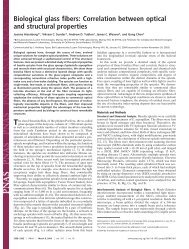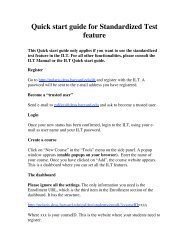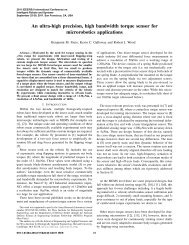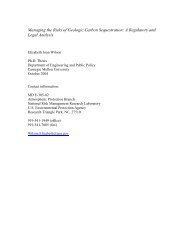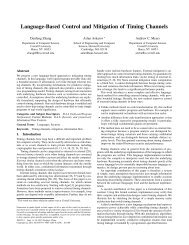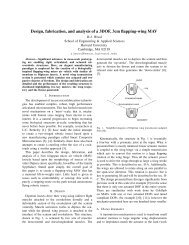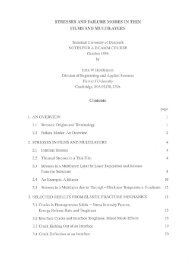CMOS RF Biosensor Utilizing Nuclear Magnetic Resonance
CMOS RF Biosensor Utilizing Nuclear Magnetic Resonance
CMOS RF Biosensor Utilizing Nuclear Magnetic Resonance
Create successful ePaper yourself
Turn your PDF publications into a flip-book with our unique Google optimized e-Paper software.
1630 IEEE JOURNAL OF SOLID-STATE CIRCUITS, VOL. 44, NO. 5, MAY 2009<br />
Fig. 2. (a) Water in a magnetic field B . (b) Excitation (top) and reception (bottom) phase in NMR. (c) Motion of magnetic moment M in NMR.<br />
evant to this work, so that readers less familiar with NMR can<br />
rapidly access the main contribution portion of this paper.<br />
A. <strong>Nuclear</strong> <strong>Magnetic</strong> <strong>Resonance</strong><br />
Atomic nuclei with spin act like tiny bar magnets. These nuclear<br />
magnets are the main actors in the NMR phenomenon. We<br />
explain NMR using protons, the simplest nuclei. Proton NMR<br />
is observed with as common a substance as water, for it contains<br />
numerous hydrogen atoms whose nuclei are protons.<br />
Let water be placed in a static magnetic field [Fig. 2(a)].<br />
After several seconds, the system reaches an equilibrium, where<br />
the proton magnets preferentially line up along the direction of<br />
, just like a compass needle lines up along the Earth’s field.<br />
Macroscopically, in the equilibrium, the water exhibits a magnetic<br />
moment along the direction of , which we take as<br />
the -axis. This equilibrium state is the lowest energy state the<br />
system assumes.<br />
Now if one wraps a coil around the water and sends an <strong>RF</strong><br />
current into the coil, one can produce an <strong>RF</strong> magnetic field<br />
across the water [Fig. 2(b), top], where and<br />
are the amplitude and angular frequency of the <strong>RF</strong> field. If is<br />
not the Larmor frequency, defined as<br />
where is a proton-specific constant yielding MHz<br />
for<br />
, the proton magnets stay indifferent to the<br />
<strong>RF</strong> field and remains along the -axis. But for ,<br />
proton magnets absorb energy from the <strong>RF</strong> field, raising the potential<br />
energy of by misaligning from with an increasing<br />
angle between them. In other words, is tipped<br />
away from the -axis. As shown at three time instants , ,<br />
and in Fig. 2(c), this downward motion of is superposed<br />
with a much faster precession of at the Larmor frequency<br />
about the -axis. Overall, exhibits a spiral downward motion,<br />
when absorbing energy from the <strong>RF</strong> field. This absorption of <strong>RF</strong><br />
energy at by the proton magnets is termed nuclear magnetic<br />
resonance (NMR). During the energy absorption, the time taken<br />
(1)<br />
for to enter the -plane [ ; , Fig. 2(c)] from its<br />
alignment along the axis [ ; ]is<br />
Typically , which is why the downward motion of<br />
(growth of ) is much slower than its precession at .<br />
How does one figure out if was tuned to and NMR<br />
took place? One can cease the <strong>RF</strong> transmission at ,<br />
connect the coil to an <strong>RF</strong> receiver, and observe the coil output<br />
after [Fig. 2(b), bottom]. If , NMR did not<br />
occur and stayed along the -axis. Thus, nothing registers<br />
at the receiver after .If , NMR took place<br />
during the <strong>RF</strong> field transmission and is in<br />
the -plane at [Fig. 2(c)]. After , there is no<br />
more <strong>RF</strong> field for protons to absorb energy from, and hence,<br />
will stay in the -plane, maintaining with a constant<br />
potential energy. 1 , however, continues to precess with<br />
about the axis in the plane. Therefore, the coil experiences<br />
a periodic magnetic flux variation that induces an <strong>RF</strong> voltage<br />
of frequency across the coil. registers at the <strong>RF</strong><br />
receiver. Note that the <strong>RF</strong> excitation is stopped at<br />
because in the -plane induces the largest signal across the<br />
coil.<br />
is actually an exponentially damped sinusoid [Fig. 2(c)]<br />
with characteristic decay time called . The damping arises<br />
because the precession of an individual proton magnet is randomly<br />
perturbed by tiny magnetic fields produced by nearby<br />
proton magnets (proton-proton interaction). Due to the perturbation,<br />
each proton precesses at but with its own phase noise.<br />
Consequently, precessions of a large number of individual protons,<br />
which were initially in phase, grow out of phase over time<br />
in the -plane. As phase coherence is lost, the vector sum<br />
of individual proton magnetic moments exponentially decays,<br />
yielding the damped signal. For water, 1 and the quality<br />
1 As mentioned, after several seconds, M will lose energy to the environment,<br />
aligning along B to reach equilibrium. The time considered here in the main<br />
text, however, is far shorter than the equilibrium restoration time.<br />
(2)



